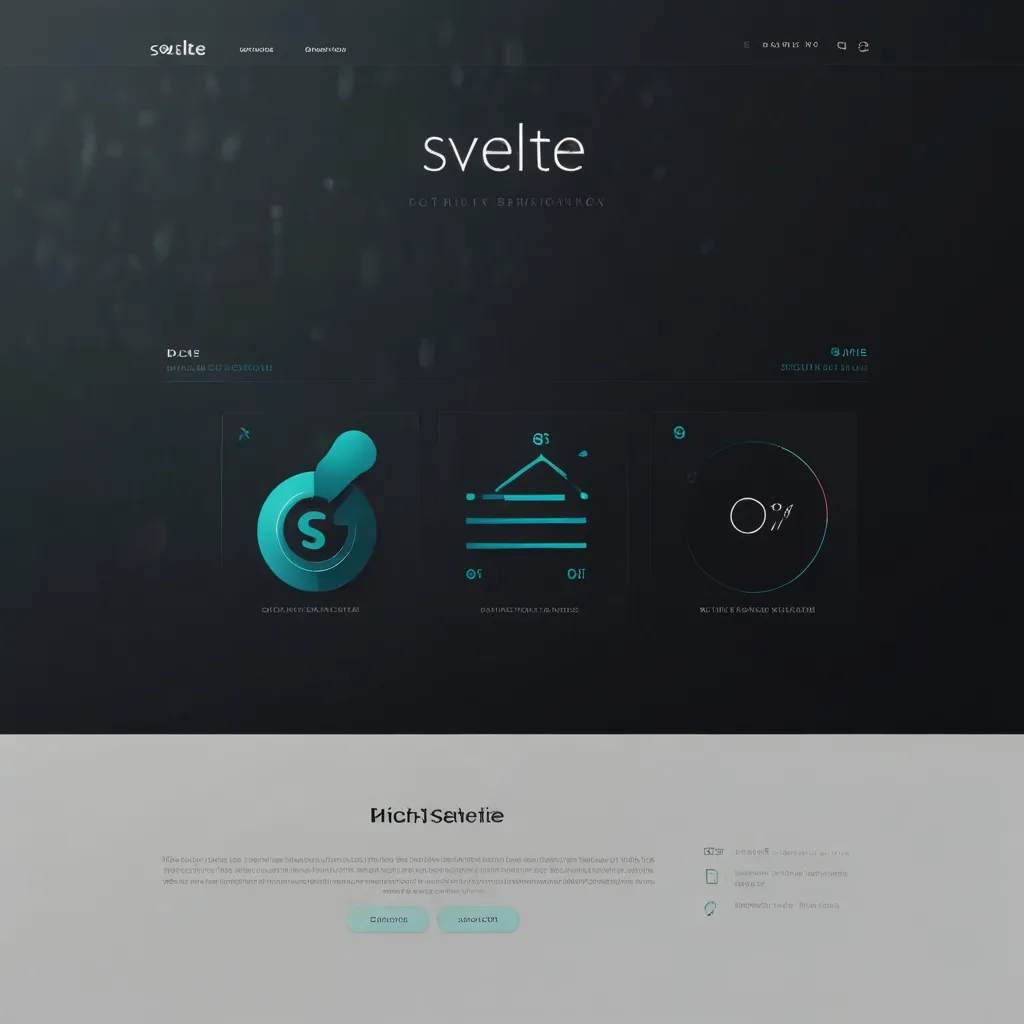Let’s dive into the fascinating world of SvelteKit, a framework that’s quietly revolutionizing web development. I’ve been tinkering with various frameworks for years, but SvelteKit genuinely caught me off guard with its elegant approach to blending server-side rendering (SSR) and single-page applications (SPAs).
Remember the days when we had to choose between the SEO benefits of SSR and the smooth user experience of SPAs? Well, those days are history. SvelteKit brings us the best of both worlds, and it does so with a simplicity that’s refreshing in today’s complex web development landscape.
At its core, SvelteKit is built on the Svelte compiler, which turns your code into highly efficient JavaScript at build time. This means your app runs faster and with less overhead than traditional frameworks. But SvelteKit takes things a step further by adding a powerful routing system and server-side rendering capabilities.
Let’s start with routing. In SvelteKit, routes are defined by the file structure in your project. It’s intuitive and requires minimal configuration. For example, if you create a file at src/routes/about.svelte, it automatically becomes available at /about in your app. This file-based routing system feels natural and helps keep your project organized.
But here’s where the magic really happens: SvelteKit seamlessly transitions between server-rendered pages and client-side navigation. When a user first visits your site, SvelteKit serves a fully rendered HTML page, ensuring fast initial load times and great SEO. As the user navigates through your app, subsequent page loads are handled client-side, providing that smooth SPA experience we all love.
Let me show you a simple example of how this works:
<!-- src/routes/index.svelte -->
<script>
import { onMount } from 'svelte';
let message = 'Loading...';
onMount(async () => {
const response = await fetch('/api/message');
message = await response.text();
});
</script>
<h1>{message}</h1>
In this example, the initial page load will show “Loading…” (server-rendered), and then quickly update with the fetched message (client-side). The transition is seamless, and the user gets the best of both worlds: fast initial load and dynamic updates.
Now, let’s talk about state management. SvelteKit leverages Svelte’s built-in stores, which provide a simple yet powerful way to manage application state. Here’s a quick example:
// src/stores/counter.js
import { writable } from 'svelte/store';
export const count = writable(0);
// src/routes/counter.svelte
<script>
import { count } from '../stores/counter';
function increment() {
count.update(n => n + 1);
}
</script>
<button on:click={increment}>
Clicks: {$count}
</button>
This code creates a simple counter that updates across your entire app. The $count syntax is a special feature in Svelte that automatically subscribes to store changes and updates the DOM accordingly.
One of my favorite features in SvelteKit is its built-in prefetching. It automatically prefetches the code for other routes when you hover over links, making navigation feel instantaneous. This is a game-changer for user experience, and it’s implemented so elegantly that you barely need to think about it.
But SvelteKit isn’t just about the client-side experience. It also shines when it comes to server-side operations. You can easily create API routes or server-only logic using the same file-based routing system. For instance, creating a file at src/routes/api/users.js automatically sets up an API endpoint at /api/users.
Here’s a simple example of an API route:
// src/routes/api/users.js
export async function get() {
const users = await fetchUsersFromDatabase();
return {
body: JSON.stringify(users)
};
}
This API route will be executed on the server, allowing you to interact with databases, perform complex computations, or integrate with external services securely.
One aspect of SvelteKit that I find particularly powerful is its flexibility when it comes to deployment. Whether you’re targeting a static site host, a serverless platform, or a traditional server setup, SvelteKit has you covered. It can adapt to various deployment scenarios, making it a versatile choice for different project requirements.
The framework also excels in its approach to progressive enhancement. By default, SvelteKit applications work without JavaScript enabled, ensuring accessibility and compatibility across a wide range of devices and browsers. This is a crucial consideration in today’s diverse web landscape, and it’s baked right into the framework’s design.
As I’ve worked with SvelteKit, I’ve come to appreciate its thoughtful approach to modern web development challenges. For instance, its handling of code splitting is impressive. It automatically splits your code into small, manageable chunks and only loads what’s necessary for each route. This results in faster load times and better performance, especially on mobile devices.
Another area where SvelteKit shines is in its support for TypeScript. While not required, using TypeScript with SvelteKit is a breeze. The framework provides excellent type definitions out of the box, enhancing developer productivity and code quality.
Let’s look at a TypeScript example:
// src/routes/greet/[name].ts
import type { RequestHandler } from '@sveltejs/kit';
export const get: RequestHandler = ({ params }) => {
return {
body: `Hello, ${params.name}!`
};
}
This creates a dynamic route that greets the user based on the URL parameter. The TypeScript integration ensures that params.name is correctly typed, providing better autocomplete and error checking in your IDE.
One aspect of SvelteKit that I find particularly exciting is its potential for creating truly interactive, real-time applications. By combining SvelteKit with WebSocket connections or server-sent events, you can build apps that update in real-time without sacrificing the benefits of server-side rendering.
Here’s a simple example of how you might set up a real-time connection in SvelteKit:
// src/routes/realtime.svelte
<script>
import { onMount } from 'svelte';
let messages = [];
onMount(() => {
const eventSource = new EventSource('/api/events');
eventSource.onmessage = (event) => {
messages = [...messages, JSON.parse(event.data)];
};
return () => eventSource.close();
});
</script>
<ul>
{#each messages as message}
<li>{message.text}</li>
{/each}
</ul>
This code sets up a connection to a server-sent events endpoint and updates the UI in real-time as new messages arrive. The server-side component of this could be implemented as an endpoint that keeps the connection open and sends events as they occur.
As I’ve delved deeper into SvelteKit, I’ve found that it encourages a component-based architecture that feels natural and intuitive. Components in Svelte (and by extension, SvelteKit) are self-contained units of markup, styles, and logic. This promotes reusability and makes it easier to reason about your application’s structure.
Here’s an example of a simple reusable component in SvelteKit:
<!-- src/lib/Button.svelte -->
<script>
export let text = 'Click me';
export let onClick = () => {};
</script>
<button on:click={onClick}>
{text}
</button>
<style>
button {
background-color: #4CAF50;
border: none;
color: white;
padding: 15px 32px;
text-align: center;
text-decoration: none;
display: inline-block;
font-size: 16px;
margin: 4px 2px;
cursor: pointer;
}
</style>
This component can be easily imported and used across your application, promoting consistency and reducing code duplication.
One of the things that sets SvelteKit apart is its approach to CSS. Unlike many frameworks that require complex setup for CSS-in-JS or scoped styles, SvelteKit (through Svelte) provides scoped styles out of the box. Any styles defined in a component are automatically scoped to that component, preventing unintended style leakage and making it easier to reason about your application’s styling.
As we wrap up this exploration of SvelteKit, I can’t help but feel excited about the future of web development. Frameworks like SvelteKit are pushing the boundaries of what’s possible on the web, making it easier than ever to create fast, interactive, and user-friendly applications.
From its elegant routing system to its seamless blend of server-side rendering and client-side interactivity, SvelteKit offers a fresh perspective on web development. It challenges us to rethink our approach to building for the web, encouraging practices that lead to better performance, improved user experience, and more maintainable codebases.
Whether you’re building a simple blog or a complex web application, SvelteKit provides the tools and flexibility to bring your vision to life. Its growing ecosystem, supportive community, and continuous improvements make it a framework worth watching and, in my opinion, worth adopting for your next project.
As we continue to push the boundaries of what’s possible on the web, frameworks like SvelteKit will play a crucial role in shaping the future of web development. It’s an exciting time to be a web developer, and I, for one, can’t wait to see what we’ll build next with tools like SvelteKit at our disposal.






